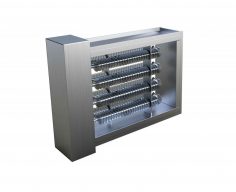Finned Tubular Heating
Finned tubular heating elements from WATTCO™ are the most versatile and dependable electric heating element available today. These industrial heating solutions are among the most common heaters and are best suited for a large number of applications such as conduction, convection, and radiation. WATTCO™ factory-configures every tubular process heater to almost any shape or size. Custom bending diameters can be made upon request. WATTCO uses the finest materials in construction such as steel, stainless steel, incoloy, inconel and/or titanium alloys. WATTCO also uses high quality magnesium oxide to allow for efficient heat transfer from resistive coil to your heating medium whether it is air, liquid or solid. These heater elements have a strong outer sheath to help protect the heater from physical stress and uses high quality alloys to allow efficient heat transfer from resistance coil to your heating medium. Depending on their rating, sheath and shape, WATTCO™ electric tubular elements are used in a variety of heat applications that require process temperatures of up to 750°C (1 382°F) to heat liquids, gases and solids. A variety of diameters are available to help adjust watt densities in your application to design these electric heaters for best performance and long life. Standard and custom made terminal pins allow for easy installation and maintenance. Bending radiuses are designed with careful expertise to allow for optimal performance when meeting “form fit and function” within your application.
Get a quote on a tubular heater today. WATTCO also manufactures other industrial heating products such as infrared heaters, immersion heaters, circulation heaters and more. Click here to view all of our products. 

- Standard diameters: 0.260 inch , 0.315 inch , 0.375 inch , 0.430 inch , 0.475 and 0.625 inch diameters
- Available in a broad variety of sheaths, diameters, and ratings
- Supplied with electrically insulated sheath
- Provide superior internal electrical insulation and heat conductivity
- CSA, CSA US & UL approved


